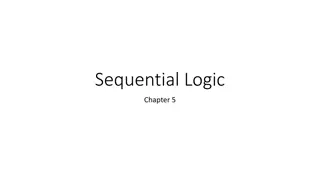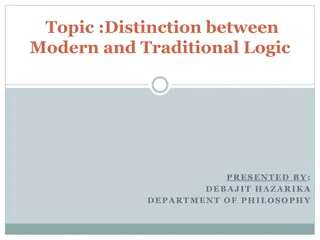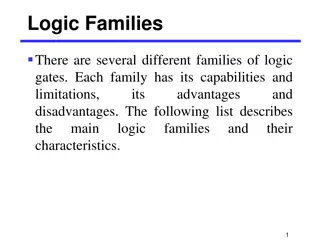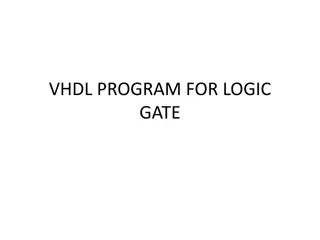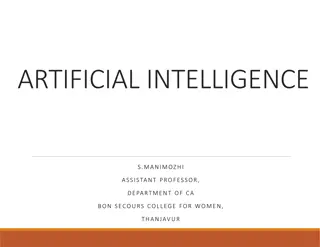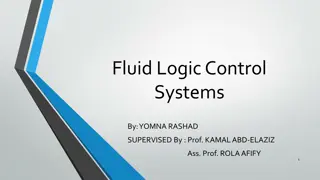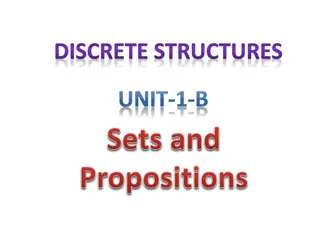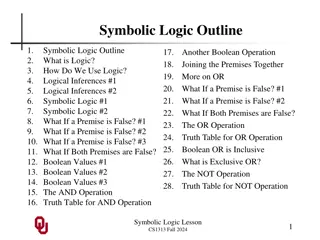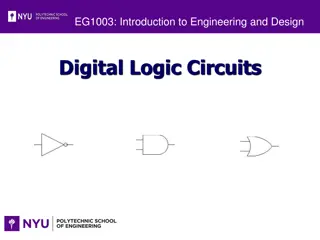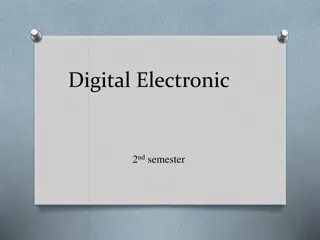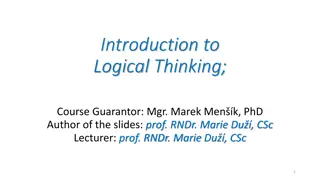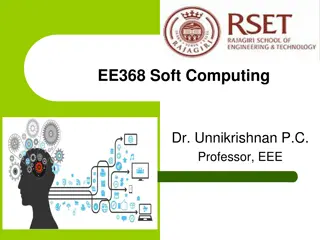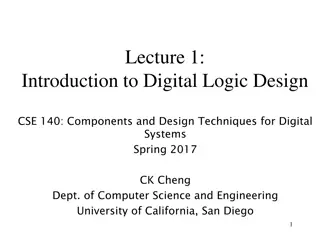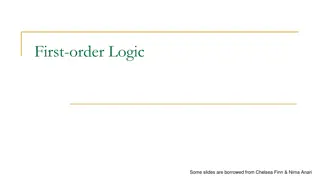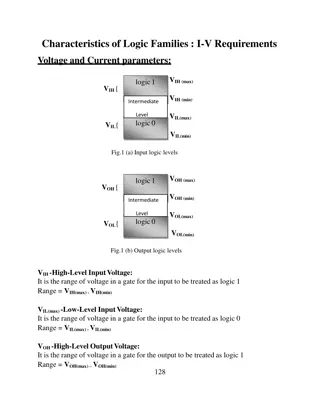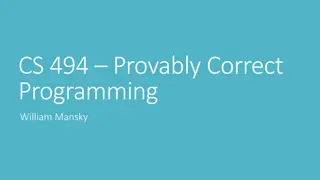Introduction to Digital Logic Systems
A digital system can understand positional number systems where symbols represent values based on their position. Learn about types of number systems, including binary, octal, and hexadecimal. Explore characteristics and examples of the binary number system and understand how to calculate decimal equivalents. Dive into the world of digital logic!
Download Presentation

Please find below an Image/Link to download the presentation.
The content on the website is provided AS IS for your information and personal use only. It may not be sold, licensed, or shared on other websites without obtaining consent from the author.If you encounter any issues during the download, it is possible that the publisher has removed the file from their server.
You are allowed to download the files provided on this website for personal or commercial use, subject to the condition that they are used lawfully. All files are the property of their respective owners.
The content on the website is provided AS IS for your information and personal use only. It may not be sold, licensed, or shared on other websites without obtaining consent from the author.
E N D
Presentation Transcript
DIGITAL LOGIC N.JAFRIN ASSISTANT PROFESSOR DEPARTMENT OF COMPUTER SCIENCE & IT JAMAL MOHAMED COLLEGE(AUTONOMOUS) TRICHY
INTRODUCTION NUMBER SYSTEM NUMBER SYSTEM A digital system can understand positional A digital system can understand positional number system only where there are a few symbols number system only where there are a few symbols called digits and these symbols represent different called digits and these symbols represent different values depending on the position they occupy in the values depending on the position they occupy in the number. number. A value of each digit in a number can be determined A value of each digit in a number can be determined using using The Thedigit digit The Theposition positionof ofthe thedigit The The base base of of the the number number system is is defined defined as as the the total available availablein inthe thenumber numbersystem) digitin inthe thenumber number system (where total number number of of digits system).. (where base base digits
TYPES OF NUMBER SYSTEM In the digital computer, there are various types of number systems used for representing information
TYPES OF NUMBER SYSTEM S.N Number System & Description S.N Number System & Description 1 Binary Number System Binary Number System Base 2. Digits used: 0, 1 Octal Number System Octal Number System Base 8. Digits used: 0to 7 Hexa HexaDecimal Number Decimal Number System System Base 16. Digits used: 0 to 9, Letters used: A-F Decimal Number system base: 10, Digits used: 0 to 9. 2 3 4
BINARY NUMBER SYSTEM Characteristics Characteristics Uses two digits, 0 and 1. Uses two digits, 0 and 1. Also called base 2 number system Also called base 2 number system Each position in a binary number represents Each position in a binary number represents power of the base (2). Example: 2 power of the base (2). Example: 20 0 Examples: Examples: (10100)2, (11011)2, (11001)2, (000101)2, (011010)2.
BINARY NUMBER SYSTEM Example Example Binary Number : 10101 Binary Number : 101012 2 Calculating Decimal Equivalent Calculating Decimal Equivalent Step Binary Step Binary NumberDecimal NumberDecimalNumber Step 1 : Step 1 : 10101 101012 2((1 ((1 2 24 4) + (0 ) + (0 2 23 3) + (1 Step 2: 10101 Step 2: 101012 2(16 + 0 + 4 + 0 + 1) (16 + 0 + 4 + 0 + 1)10 10 Step 3: 10101 Step 3: 101012 2 - - 21 2110 10 Note: Note:10101 101012 2is normally written as 10101. is normally written as 10101. Number ) + (1 2 22 2) + (0 ) + (0 2 21 1) + (1 ) + (1 2 20 0)) ))10 10
DECIMAL NUMBER SYSTEM The decimal numbers are used in our day to day life. The decimal numbers are used in our day to day life. The decimal number system contains ten digits from The decimal number system contains ten digits from 0 to 9(base 10). 0 to 9(base 10). Here, the successive place value or position, left to the Here, the successive place value or position, left to the decimal point holds units, tens, hundreds, thousands, decimal point holds units, tens, hundreds, thousands, and so on. and so on. The 0 is the minimum value of the digit, and 9 is the The 0 is the minimum value of the digit, and 9 is the maximum value of the digit. maximum value of the digit.
DECIMAL NUMBER SYSTEM For example: For example: The decimal number 2541 consist of the digit The decimal number 2541 consist of the digit 1 in the unit position, 4 in the tens position, 5 in the 1 in the unit position, 4 in the tens position, 5 in the hundreds position, and 2 in the thousand positions hundreds position, and 2 in the thousand positions and the value will be written as: and the value will be written as: = (2 = (2 1000) + (5 1000) + (5 100) + (4 100) + (4 10) + (1 (5 (5 10 102 2) + (4 ) + (4 10 101 1) + (1 ) + (1 10 100 0) ) = 2000 + 500 + 40 + 1 = 2000 + 500 + 40 + 1 =2541 =2541 1) (2 10 103 3) + 10) + (1 1) (2 ) +
OCTAL NUMBER SYSTEM Characteristics Characteristics Uses eight digits, 0,1,2,3,4,5,6,7. Uses eight digits, 0,1,2,3,4,5,6,7. Also called base 8 number system Also called base 8 number system Each position in an octal number represents Each position in an octal number represents a 0 power of the base (8). Example: 8 a 0 power of the base (8). Example: 80 0
OCTAL NUMBER SYSTEM Example Octal Number 125708 Calculating Decimal Equivalent Step Octal Number Decimal Number Step 1: 125708 = ((1 84) + (2 83) + (5 82) + (7 81) + (0 80))10 Step 2: 125708= (4096 + 1024 + 320 + 56 + 0)10 Step 3: 125708= 549610
HEXADECIMAL NUMBER SYSTEM Characteristics Characteristics Uses 10 digits and 6 letters, Uses 10 digits and 6 letters, 0,1,2,3,4,5,6,7,8,9,A,B,C,D,E,F. 0,1,2,3,4,5,6,7,8,9,A,B,C,D,E,F. Letters represents numbers starting from 10. Letters represents numbers starting from 10. A = 10, B = 11, C = 12, D = 13, E = 14, F = 15. A = 10, B = 11, C = 12, D = 13, E = 14, F = 15. Also called base 16 number system. Also called base 16 number system. Each position in a hexadecimal number Each position in a hexadecimal number represents a 0 power of the base (16). represents a 0 power of the base (16). Example: 16 Example: 160 0..
HEXADECIMAL NUMBER SYSTEM Hexadecimal Number: 19FDE Hexadecimal Number: 19FDE16 16 Calculating Decimal Equivalent Calculating Decimal Equivalent Step Hexadecimal Number Decimal Number Step Hexadecimal Number Decimal Number Step 1: Step 1: 19FDE 19FDE16 = ((1 16 164 4) + (9 ) + (9 16 163 3) + (F (E (E 16 160 0)) ))10 10 Step 2: Step 2: 19FDE 19FDE16 16= ((1 = ((1 16 164 4) + (9 ) + (9 16 163 3) + (15 (14 (14 16 160 0)) ))10 10 Step 3: 19FDE Step 3: 19FDE16 = (65536 + 36864 + 3840 + 208 + 14)10 10 Step 4 : 19FDE Step 4 : 19FDE16 = 10646210 10 ) + (F 16 162 2) + (D ) + (D 16 161 1) + 16 = ((1 ) + ) + (15 16 162 2) + (13 ) + (13 16 161 1) + ) + 16 = (65536 + 36864 + 3840 + 208 + 14) 16 = 106462
NUMBER BASE CONVERSION In our previous section, we learned different types of In our previous section, we learned different types of number systems such as binary, decimal, octal, and number systems such as binary, decimal, octal, and hexadecimal. In this part we will learn how we can change hexadecimal. In this part we will learn how we can change a number from one number system to another number a number from one number system to another number system. system. four types of number systems so each one can four types of number systems so each one can be converted into the remaining three systems. There are be converted into the remaining three systems. There are the following conversions possible in Number System the following conversions possible in Number System Binary to other Number Systems. Binary to other Number Systems. Decimal to other Number Systems. Decimal to other Number Systems. Octal to other Number Systems. Octal to other Number Systems. Hexadecimal to other Number Systems. Hexadecimal to other Number Systems.
NUMBER BASE CONVERSION
NUMBER BASE CONVERSION
DECIMAL NUMBER TO OTHER BASES CONVERSION 1. Decimal to Binary : 1. Decimal to Binary : The following two types of operations take place, The following two types of operations take place, while converting decimal number into its equivalent while converting decimal number into its equivalent binary number. binary number. Division of integer part and successive quotients Division of integer part and successive quotients with base 2. with base 2. Multiplication of fractional part and successive Multiplication of fractional part and successive fractions with base 2 fractions with base 2. Example Example (10.25) (10.25)10 10 I. I. II. II.
DECIMAL TO BINARY DECIMAL TO BINARY Answer: (10.25)10= (1010.01)2
DECIMAL TO OCTAL The following two types of operations take place, while The following two types of operations take place, while converting decimal number into its equivalent octal converting decimal number into its equivalent octal number. number. Division of integer part and successive quotients Division of integer part and successive quotients with base 8. with base 8. Multiplication of fractional part and successive Multiplication of fractional part and successive fractions with base 8. fractions with base 8. Example Example (58.25)10 (58)10= (72)8 Fractional part: 0.25 x 8 = 2.00 theoctal equivalent octal equivalentof decimal number 58.25 is 72.2. I. I. II. II.
DECIMAL TO HEXA- DECIMAL CONVERSION The following two types of operations take place, while converting decimal number into its equivalent hexa- decimal number. Division of integer part and successive quotients with base 16. Multiplication of fractional part and successive fractions with base 16. Example Example Consider the Consider thedecimal number 58.25. decimal number 58.25. Here, the integer part is 58 and decimal part is Here, the integer part is 58 and decimal part is 0.25. 0.25. I. II.
DECIMAL TO HEXA- DECIMAL CONVERSION Step 1 Step 1 Division of 58 and successive quotients with Division of 58 and successive quotients with base 16. base 16. Operation Operation 58/16 58/16 3/16 3/16 Quotient Quotient 3 3 0 0 Remainder Remainder 10=A 10=A 3 3 58 5810 10= =3A 3A16 16 Step 2 Step 2 Multiplication of 0.25 and successive fractions Multiplication of 0.25 and successive fractions with base 16. with base 16. Operation Operation Result Result 0.25 x 16 0.25 x 16 4.00 4.00 - - 0.00 0.00 .25 2510 10= =.4 .416 16 Carry Carry 4 4 - -
BINARY NUMER SYSTEM TO OTHER NUMBER SYSTEM Shortcut method Shortcut method - - Binary to Octal Steps Steps Step 1 Divide the binary digits into groups of three Divide the binary digits into groups of three (starting from the right). (starting from the right). Step 2 Convert each group of three binary digits to Convert each group of three binary digits to one octal digit. one octal digit. Binary to Octal Step 1 Step 2 Example Example Binary Number 10101 Binary Number 101012 2
BINARY TO OCTAL Shortcut method Shortcut method - - Binary to Octal Steps Steps Step 1 Divide the binary digits into groups of three Divide the binary digits into groups of three (starting from the right). (starting from the right). Step 2 Convert each group of three binary digits to Convert each group of three binary digits to one octal digit. one octal digit. Binary to Octal Step 1 Step 2 Example Example Binary Number 10101 Binary Number 101012 2
BINARY TO OCTAL Step Binary Number Octal Number Step 1 101012 101012 101012 010 101 Step 2 2858 258 Step 3 Binary Number 101012= Octal Number 258
BINARY TO DECIMAL NUMBER SYSTEM Positional Notation Most Binary Point Least Significant Bit (LSB) Significant Bit (MSB) 22 21 20 2-1 2-2 2-3 4 2 1 0.5 0.25 0.125 Example-1 Convert binary number 11001010 into decimal number
BINARY TO DECIMAL NUMBER SYSTEM Example-1 Convert binary number 11001010 into decimal number = (11001010)2 =1x27+1x26+0x25+0x24+1x23+0x22+1x21+0x20 = 128+64+0+0+8+0+2+0 = (202)10
BINARY TO DECIMAL NUMBER SYSTEM Example-2 Convert binary number 1010.1011 into decimal number. Binary to decimal is, = (1010.1011)2 = 1x23+0x22+1x21+0x20+1x2-1+0x2-2+1x2-3+1x2-4 = 8+0+2+0+0.5+0+0.125+0.0625 = (10.6875)10
BINARY TO HEXADECIMAL NUMBER SYSTEM Hexa 0 1 2 3 4 5 6 7 Binary 0000 0001 0010 0011 0100 0101 0110 0111 Hexa 8 9 A B C D E F Binary 1000 1001 1010 1011 1100 1101 1110 1111 steps to convert a binary number into hexadecimal number: Take binary number Divide the binary digits into groups of four (starting from right) for integer part and start from left for fraction part. Convert each group of four binary digits to one hexadecimal digit.
BINARY TO HEXADECIMAL NUMBER SYSTEM Example-1 Convert binary number 1010101101001 into hexadecimal number. Binary to hexadecimal is, = (1010101101001)2 = (1 0101 0110 1001)2 = (0001 0101 0110 1001)2 = (1 5 6 9)16 = (1569)16
BINARY TO HEXADECIMAL NUMBER SYSTEM Example-2 Convert binary number 001100101.110111 into hexadecimal number. Binary to hexadecimal is, = (001100101.110111)2 = (0 0110 0101 . 1101 1100)2 = (0110 0101 . 1101 1100)2 = (6 5 . D C)16 = (65.DC)16
CONVERT OCTAL TO BINARY USING TABLE Octal Number Equivalent Binary Number 0 000 1 001 2 010 3 011 4 100 5 101 6 110 7 111
CONVERT OCTAL TO BINARY USING TABLE Example: Convert 128into a binary number. Solution: Given, 128is the octal number. Now with the help of the table, we can write; 128= (001 010)2 Example-2 Convert octal number 352.563 into binary number. According to above algorithm, equivalent binary number will be, = (352.563)8 = (011 101 010 . 101 110 011)2 = (011101010.101110011)2
OCTAL TO DECIMAL CONVERSION The digits of given octal number starting from right most digit and keep a variable dec_value. At the time of extracting digits from the octal number, multiply the digit with the proper base (Power of 8) and add it to the variable dec_value. At the end, the variable dec_value will store the required decimal number. For Example: If the octal number is 67. dec_value = 6*(8^1) + 7*(8^0) = 55
OCTAL TO DECIMAL CONVERSION EXAMPLE-2:
HEXADECIMAL TO DECIMAL Example:1 9 = 9 * (16 ^ 0) = 9 C = 12 * (16 ^ 1) = 192 Then, we add the results. =192 + 9 = 20110decimal Example:2 The hex number A3C2. 2 x (160) = 2 x 1 = 2 C x (161) = 12 x 16 = 192 3 x (162) = 3 x (16 x 16) = 3 x 256 = 768 A x (163) = 10 x (16 x 16 x 16) = 10 x 4096 = 40960 Add the results together: 2 + 192 + 768 + 40960 = 41922 So the decimal equivalent of A3C2 is 41922.
HEXADECIMAL TO BINARY CONVERSION Step 1: are any, change the hex values represented by letters to their decimal equivalents. Step 2: Each hex digit represents four binary digits and therefore is equal to a power of 2. The rightmost digit equals to 20(1), the next one equals to 21(2), the next one equals to 22(4) and the leftmost one equals to 23(8). Write these numbers (8, 4, 2 and 1) below the hex values. Step 3: Determine which powers of two (8, 4, 2 or 1) sum up to your hex digits. For example, if one of your hex values is 10, this means 8 and 2 sum up to 10 (4 and 1 are not used). If your hex number is 2, only 2 is used; 8, 4 and 1 are not. Write down the hex number. If there
HEXADECIMAL TO BINARY CONVERSION Step 4: 1 s that are used. Write down 0 below those that are not used. Step 5: Read the 1 s and 0 s from left to right to get the binary equivalent of the given hex number. Write down 1 below those 8, 4, 2 and Let's apply these steps to the hex number (4FA)16 4 F A 4 15 10
HEXADECIMAL TO BINARY CONVERSION Step 2: 4 F A 4 15 10 8421 8421 8421 0100 1111 1010 Step 3: (4FA)16 = (10011111010)2 Example 2: (2C1)16 = (1011000001)2 2 2 8421 0010 C 12 8421 8421 1100 1 1 0001
HEXADECIMAL TO OCTAL Method to Convert Hex to Octal For each given hexadecimal number digit, write the equivalent binary number. If any of the binary equivalents are less than 4 digits, add 0 s to the left side. Combine and make the groups of binary digits from right to left, each containing 3 digits. Add 0 s to the left if there are less than 3 digits in the last group. Find the octal equivalent of each binary group.
HEXADECIMAL TO OCTAL Example: Convert 1BC16into an octal number. Solution: Given, 1BC16is a hexadecimal number. 1 0001, B 1011, C 1100 Now group them from right to left, each having 3 digits. 000, 110, 111, 100 000 0, 110 6, 111 7, 100 4 Hence, 1BC16= 6748
GATES The basic digital electronic circuit that has one or more inputs and single output is known as Logic gate. Hence, the Logic gates are the building blocks of any digital system. We can classify these Logic gates into the following two categories. Basic gates Universal gates Basic gates are AND OR NOT gates.
BASIC GATES AND gate An AND gate is a digital circuit that has two or more inputs and produces an output, which is the logical AND of all those inputs. It is optional to represent the Logical AND with the symbol . . The following table shows the truth table of 2-input AND gate. A B Y = A.B 0 0 0 0 1 0 1 0 0 1 1 1
BASIC GATES AND gate Here A, B are the inputs and Y is the output of two input AND gate. If both inputs are 1 , then only the output, Y is 1 . For remaining combinations of inputs, the output, Y is 0 . The following figure shows the symbol of an AND gate, which is having two inputs A, B and one output, Y.
BASIC GATES OR gate An OR gate is a digital circuit that has two or more inputs and produces an output, which is the logical OR of all those inputs. This logical OR is represented with the symbol + . The following table shows the truth table of 2-input OR gate. A B Y = A + B 0 0 0 0 1 1 1 0 1 1 1 1
BASIC GATES Here A, B are the inputs and Y is the output of two input OR gate. If both inputs are 0 , then only the output, Y is 0 . For remaining combinations of inputs, the output, Y is 1 . The following figure shows the symbol of an OR gate, which is having two inputs A, B and one output, Y.
BASIC GATES NOT gate A NOT gate is a digital circuit that has single input and single output. The output of NOT gate is the logical inversion of input. Hence, the NOT gate is also called as inverter. The following table shows the truth table of NOT gate. A Y = A 0 1 1 0
BASIC GATES Here A and Y are the input and output of NOT gate respectively. If the input, A is 0 , then the output, Y is 1 . Similarly, if the input, A is 1 , then the output, Y is 0 . The following figure shows the symbol of NOT gate, which is having one input, A and one output, Y.
UNIVERSAL GATES NAND & NOR gates are called as universal gates. Because we can implement any Boolean function, which is in sum of products form by using NAND gates alone. Similarly, we can implement any Boolean function, which is in product of sums form by using NOR gates alone. NAND gate NAND gate is a digital circuit that has two or more inputs and produces an output, which is the inversion of logical AND of all those inputs. The following table shows the truth table of 2-input NAND gate.
UNIVERSAL GATES Y = (A.B) A B 0 0 1 0 1 1 1 0 1 1 1 0 Here A, B are the inputs and Y is the output of two input NAND gate. When both inputs are 1 , the output, Y is 0 . If at least one of the input is zero, then the output, Y is 1 . This is just opposite to that of two input AND gate operation. The following image shows the symbol of NAND gate, which is having two inputs A, B and one output, Y.
UNIVERSAL GATES NAND gate operation is same as that of AND gate followed by an inverter. Now we will see how this gate can be used to make other gates.
UNIVERSAL GATES Now we will see the design of an AND gate from NAND gates. NOR Gate Logic diagram


